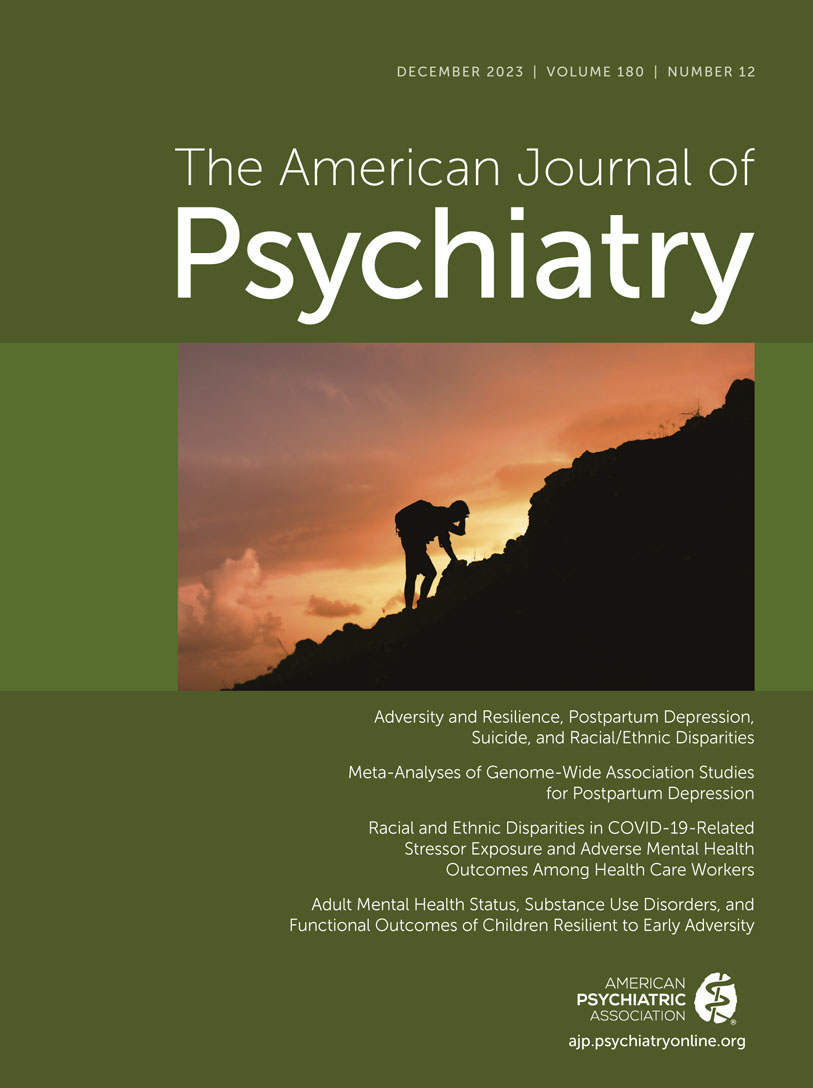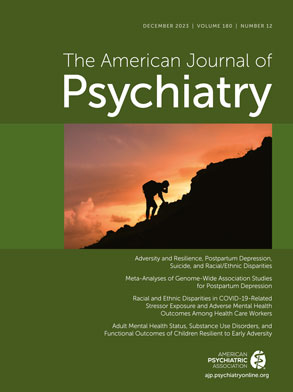Despite being one of the most common and debilitating complications of childbirth, postpartum depression (PPD) remains chronically underdiagnosed and undertreated (
1). PPD affects an estimated 17% of the global population, and any postpartum mother can be affected, although risk factors include personal or family history of major depressive disorder (MDD), poor social support, partner violence, and lower socioeconomic status (
2). Symptoms of PPD include diminished energy, concentration, memory, and appetite, feelings of apathy, guilt, and helplessness, and thoughts of suicide or harming oneself or the baby (
1). These symptoms often lead to difficulty caring for and bonding with the child, which detrimentally affects the child’s cognitive, emotional, and behavioral development and can sometimes lead to severe neglect and even infanticide (
1). Despite its prevalence, PPD is challenging to diagnose, as many symptoms, such as fatigue, insomnia, and anxiety, are routine effects of caring for a newborn and are often overlooked. Furthermore, studies have shown that even when PPD is suspected, the majority of women are not followed up or offered any treatment (
3). Treatment options for PPD include psychotherapy, cognitive-behavioral therapy, and conventional antidepressant medications; however, effectiveness varies greatly between individuals (
4).
Much like MDD, PPD is a multifactorial, polygenic trait that arises from the complex interplay of genetic, environmental, and psychosocial factors, with individual gene loci contributing only small effects. Depressive disorders are also highly phenotypically heterogeneous, and so extremely large sample sizes are needed to detect significant genetic associations (
5). However, PPD is much more homogeneous—it only affects women of reproductive age with exposure to the specific biopsychosocial event of childbirth. Hence, the classification of PDD as a subtype of MDD may allow for more successful genomic findings and useful guidance for diagnosis and treatment. There is growing evidence that PPD is genetically distinct; a 2016 twin heritability study found that one-third of the genetic contribution to heritability was unique to PPD and was not shared with non-postpartum depression, with PPD heritability at 54%, compared with MDD at 32% (
6). Additionally, several candidate gene studies have found preliminary associations between different gene polymorphisms and PPD that are not found in MDD, including in oxytocin (
7) and estrogen (
8) metabolism pathways.
In this issue of the
Journal, Guintivano et al. (
9) present the first ever GWAS meta-analysis to focus specifically on PPD, constituting the largest genetic study of PPD to date. The authors combined data from 20 international cohorts, including a total of 18,770 women with a history of PPD and 58,461 control subjects, to perform multiple GWAS meta-analyses and post-GWAS analyses, including single-nucleotide polymorphism (SNP)–based heritability, genetic correlations with other phenotypes, and tissue and cell-type enrichment analyses. The majority of the data came from women of European ancestry (18 cohorts; 17,339 cases, 53,426 controls); one cohort was of East Asian ancestry (975 cases, 3,780 controls), and one of African ancestry (456 cases, 1,255 controls). After testing cohort comparability using summary-level statistics, the authors conducted two GWAS analyses: a primary analysis including only the 18 cohorts of European ancestry, and a trans-ancestry random-effects analysis including all 20 cohorts. SNP heritability (h
2SNP), which measures the proportion of phenotypic variance explained by all measured SNP variants, was calculated at 0.14 for the European cohort, 0.17 for the East Asian cohort, and 0.36 for the African cohort. This is consistent with the literature on SNP heritability for MDD (h
2SNP range, 0.102–0.162) (
10).
No SNPs reached the genome-wide significance threshold (p<5×10
–8) in either GWAS analysis. The European-ancestry GWAS identified 62 SNPs at seven independent loci with p values <1×10
–6, but none of these met the genome-wide significance threshold. The trans-ancestry GWAS found further SNP associations in three of these seven loci. The most significant SNP was within
TXNRD2 (thioredoxin reductase 2), which encodes for a mitochondrial protein previously implicated in heart disease in the aging heart (
11). Other genes identified within these seven independent blocks include
PCDHA1, deletions of which are associated with schizophrenia and bipolar disorder (
12), and
ZMAT2, which was significantly associated with MDD in a recent transcriptome-wide association study (
13).
When testing genetic correlations between PPD and other phenotypes, Guintivano et al. found that the correlation between PPD and MDD was close to 1 (r
g=0.95, SE=0.05; H
0: r
g=0, p=1.34×10
–80; H
0: r
g=1, p=0.30). However, this may be due to selection bias, as 45% of analyzed PPD cases came from broader MDD-focused cohort studies. The authors also identified significant positive correlations of PPD with bipolar I and II disorders, anxiety disorders, posttraumatic stress disorder (PTSD), attention deficit hyperactivity disorder, schizophrenia, and insomnia (r
g values, 0.25–0.91). This is to be expected, as many of these conditions are commonly comorbid with PPD—up to one-third of women who are diagnosed with PPD will also experience PTSD associated with childbirth (
14), and an estimated 22.6% are also diagnosed with comorbid bipolar disorder (
15). There were additional significant correlations between PPD and age at menarche (r
g=0.11) and polycystic ovary syndrome (PCOS) (r
g=0.23), suggesting common genes associated with these disorders.
As a final post-GWAS analysis, Guintivano et al. integrated their GWAS results with RNA sequencing data to investigate SNP enrichment in 27 human tissue types from the Genotype-Tissue Expression (GTEx) project and 39 cell types from studies in the central and peripheral nervous systems of mice. They found no bulk tissue enrichment in any of the GTEx tissues. In the mouse cell types, the strongest signals the authors identified were inhibitory neurons in the thalamus (p=4.5×10–4) and cholinergic neurons in the septal nuclei of the hypothalamus (p=7.64×10–3). Both of these are GABAergic neurons, producing gamma-aminobutyric acid (GABA), the main inhibitory neurotransmitter in the mammalian CNS. These cell types were significantly more enriched in PPD-associated genes compared with MDD genes, which could suggest unique cell targets for PPD treatment.
In 2019, the U.S Food and Drug Administration (FDA) approved the first PPD-specific drug therapy—an intravenous infusion of brexanolone, a synthetic allopregnanolone analogue—which has found some success; however, the treatment has considerable side effect risks, and it is administered intravenously over a 60-hour period, impeding accessibility (
16). In 2023, the FDA approved an improved, fast-acting, orally administered synthetic allopregnanolone, named zuranolone, which reduces the accessibility concerns but has similar side effect risks (
17). Both of these pharmaceutical treatments target GABAergic neurons (
16,
17), and the results of larger, more homogeneous samples may help to identify novel drug targets within the same biological pathway to create improved, more accessible therapies with decreased side effects.
The promising results of this meta-analysis by Guintivano et al. pave the way for future studies with larger, more ethnically diverse populations to further map the genetic architecture of PPD. Still, PPD remains underrecognized and underresearched and is seldom measured in genetic studies, and when data are gathered on PPD, it is often included with MDD and missing important details, such as time of onset after childbirth. Future studies should ensure that lifetime data on PPD are gathered, with standardized criteria and postpartum cutoff point to separate it from MDD. While gathering data from different ancestry groups is important, data on childhood trauma, poverty, discrimination, and intimate partner violence should also be collected. There is a vital need for better clinical assessment of PPD in maternal health services, and using standardized diagnostic interviews, checking for comorbidities, and collecting biological samples longitudinally would provide a massive source of data for future GWAS studies. This would not only increase statistical power to detect novel genes associated with PPD, but also provide a clinical framework for early detection, treatment, and support for PPD.

